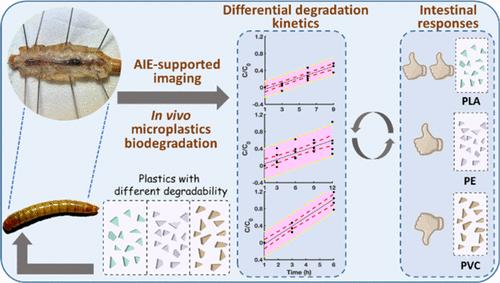当前位置:
X-MOL 学术
›
Environ. Sci. Technol.
›
论文详情
Our official English website, www.x-mol.net, welcomes your
feedback! (Note: you will need to create a separate account there.)
Microplastics Biofragmentation and Degradation Kinetics in the Plastivore Insect Tenebrio molitor
Environmental Science & Technology ( IF 10.8 ) Pub Date : 2024-07-19 , DOI: 10.1021/acs.est.4c05113 Bo-Yu Peng 1, 2 , Wen-Xiong Wang 1, 2
Environmental Science & Technology ( IF 10.8 ) Pub Date : 2024-07-19 , DOI: 10.1021/acs.est.4c05113 Bo-Yu Peng 1, 2 , Wen-Xiong Wang 1, 2
Affiliation

|
The insect Tenebrio molitor possesses an exceptional capacity for ultrafast plastic biodegradation within 1 day of gut retention, but the kinetics remains unknown. Herein, we investigated the biofragmentation and degradation kinetics of different microplastics (MPs), i.e., polyethylene (PE), poly(vinyl chloride) (PVC), and poly(lactic acid) (PLA), in T. molitor larvae. The intestinal reactions contributing to the in vivo MPs biodegradation were concurrently examined by utilizing aggregated-induced emission (AIE) probes. Our findings revealed that the intestinal biofragmentation rates essentially followed the order of PLA > PE > PVC. Notably, all MPs displayed retention effects in the intestine, with PVC requiring the longest duration for complete removal/digestion. The dynamic rate constant of degradable MPs (0.2108 h–1 for PLA) was significantly higher than that of persistent MPs (0.0675 and 0.0501 h–1 for PE and PVC, respectively) during the digestive gut retention. Surprisingly,T. molitor larvae instinctively modulated their internal digestive environment in response to in vivo biodegradation of various MP polymers. Esterase activity and intestinal acidification both significantly increased following MPs ingestion. The highest esterase and acidification levels were observed in the PLA-fed and PVC-fed larvae, respectively. High digestive esterase activity and relatively low acidification levels inT. molitor larvae may, to some extent, contribute to more efficient MPs removal within the plastic-degrading insect. This work provided important understanding of MPs biofragmentation and intestinal responses to in vivo MPs biodegradation in plastic-degrading insects.
中文翻译:

黄粉虫中微塑料的生物碎片和降解动力学
昆虫黄粉虫具有在肠道滞留 1 天内超快塑料生物降解的非凡能力,但其动力学仍然未知。在此,我们研究了不同微塑料(MP),即聚乙烯(PE)、聚氯乙烯(PVC)和聚乳酸(PLA)在黄鹳幼虫中的生物碎片和降解动力学。利用聚集诱导发射(AIE)探针同时检查了促进体内MP 生物降解的肠道反应。我们的研究结果表明,肠道生物碎片率基本上遵循 PLA > PE > PVC 的顺序。值得注意的是,所有 MP 都在肠道中表现出滞留效应,其中 PVC 需要最长的持续时间才能完全去除/消化。在消化道滞留期间,可降解 MP 的动态速率常数(PLA 为 0.2108 h –1 )显着高于持久性 MP(PE 和 PVC 分别为 0.0675 和 0.0501 h –1 )。令人惊讶的是,黄飞虱幼虫本能地调节其内部消化环境,以响应各种 MP 聚合物的体内生物降解。摄入 MP 后,酯酶活性和肠道酸化均显着增加。在 PLA 喂养和 PVC 喂养的幼虫中分别观察到最高的酯酶和酸化水平。鼹鼠幼虫的高消化酯酶活性和相对较低的酸化水平可能在某种程度上有助于更有效地去除塑料降解昆虫中的 MP。 这项工作为塑料降解昆虫体内MP 生物降解和肠道对 MP 生物降解的反应提供了重要的理解。
更新日期:2024-07-19
中文翻译:

黄粉虫中微塑料的生物碎片和降解动力学
昆虫黄粉虫具有在肠道滞留 1 天内超快塑料生物降解的非凡能力,但其动力学仍然未知。在此,我们研究了不同微塑料(MP),即聚乙烯(PE)、聚氯乙烯(PVC)和聚乳酸(PLA)在黄鹳幼虫中的生物碎片和降解动力学。利用聚集诱导发射(AIE)探针同时检查了促进体内MP 生物降解的肠道反应。我们的研究结果表明,肠道生物碎片率基本上遵循 PLA > PE > PVC 的顺序。值得注意的是,所有 MP 都在肠道中表现出滞留效应,其中 PVC 需要最长的持续时间才能完全去除/消化。在消化道滞留期间,可降解 MP 的动态速率常数(PLA 为 0.2108 h –1 )显着高于持久性 MP(PE 和 PVC 分别为 0.0675 和 0.0501 h –1 )。令人惊讶的是,黄飞虱幼虫本能地调节其内部消化环境,以响应各种 MP 聚合物的体内生物降解。摄入 MP 后,酯酶活性和肠道酸化均显着增加。在 PLA 喂养和 PVC 喂养的幼虫中分别观察到最高的酯酶和酸化水平。鼹鼠幼虫的高消化酯酶活性和相对较低的酸化水平可能在某种程度上有助于更有效地去除塑料降解昆虫中的 MP。 这项工作为塑料降解昆虫体内MP 生物降解和肠道对 MP 生物降解的反应提供了重要的理解。











































 京公网安备 11010802027423号
京公网安备 11010802027423号